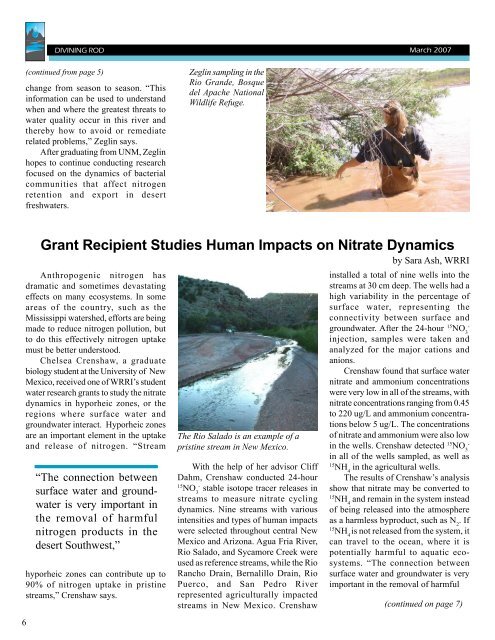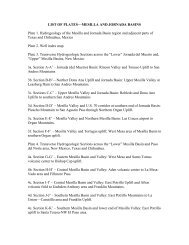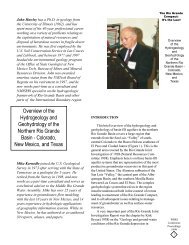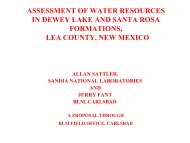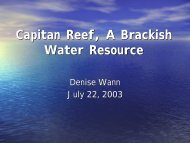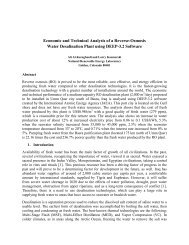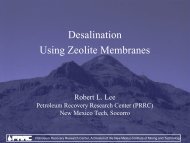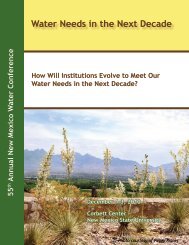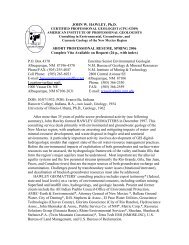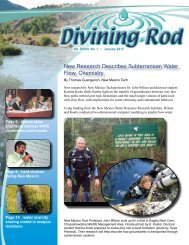Vol. XXX, No. 1 - Water Resources Research Institute - New Mexico ...
Vol. XXX, No. 1 - Water Resources Research Institute - New Mexico ...
Vol. XXX, No. 1 - Water Resources Research Institute - New Mexico ...
You also want an ePaper? Increase the reach of your titles
YUMPU automatically turns print PDFs into web optimized ePapers that Google loves.
(continued from page 5)<br />
change from season to season. “This<br />
information can be used to understand<br />
when and where the greatest threats to<br />
water quality occur in this river and<br />
thereby how to avoid or remediate<br />
related problems,” Zeglin says.<br />
After graduating from UNM, Zeglin<br />
hopes to continue conducting research<br />
focused on the dynamics of bacterial<br />
communities that affect nitrogen<br />
retention and export in desert<br />
freshwaters.<br />
Zeglin sampling in the<br />
Rio Grande, Bosque<br />
del Apache National<br />
Wildlife Refuge.<br />
6<br />
Grant Recipient Studies Human Impacts on Nitrate Dynamics<br />
by Sara Ash, WRRI<br />
Anthropogenic nitrogen has<br />
dramatic and sometimes devastating<br />
effects on many ecosystems. In some<br />
areas of the country, such as the<br />
Mississippi watershed, efforts are being<br />
made to reduce nitrogen pollution, but<br />
to do this effectively nitrogen uptake<br />
must be better understood.<br />
Chelsea Crenshaw, a graduate<br />
biology student at the University of <strong>New</strong><br />
<strong>Mexico</strong>, received one of WRRI’s student<br />
water research grants to study the nitrate<br />
dynamics in hyporheic zones, or the<br />
regions where surface water and<br />
groundwater interact. Hyporheic zones<br />
are an important element in the uptake<br />
and release of nitrogen. “Stream<br />
“The connection between<br />
surface water and groundwater<br />
is very important in<br />
the removal of harmful<br />
nitrogen products in the<br />
desert Southwest,”<br />
hyporheic zones can contribute up to<br />
90% of nitrogen uptake in pristine<br />
streams,” Crenshaw says.<br />
The Rio Salado is an example of a<br />
pristine stream in <strong>New</strong> <strong>Mexico</strong>.<br />
With the help of her advisor Cliff<br />
Dahm, Crenshaw conducted 24-hour<br />
15<br />
NO 3<br />
-<br />
stable isotope tracer releases in<br />
streams to measure nitrate cycling<br />
dynamics. Nine streams with various<br />
intensities and types of human impacts<br />
were selected throughout central <strong>New</strong><br />
<strong>Mexico</strong> and Arizona. Agua Fria River,<br />
Rio Salado, and Sycamore Creek were<br />
used as reference streams, while the Rio<br />
Rancho Drain, Bernalillo Drain, Rio<br />
Puerco, and San Pedro River<br />
represented agriculturally impacted<br />
streams in <strong>New</strong> <strong>Mexico</strong>. Crenshaw<br />
installed a total of nine wells into the<br />
streams at 30 cm deep. The wells had a<br />
high variability in the percentage of<br />
surface water, representing the<br />
connectivity between surface and<br />
groundwater. After the 24-hour 15 NO 3<br />
-<br />
injection, samples were taken and<br />
analyzed for the major cations and<br />
anions.<br />
Crenshaw found that surface water<br />
nitrate and ammonium concentrations<br />
were very low in all of the streams, with<br />
nitrate concentrations ranging from 0.45<br />
to 220 ug/L and ammonium concentrations<br />
below 5 ug/L. The concentrations<br />
of nitrate and ammonium were also low<br />
in the wells. Crenshaw detected 15 NO 3<br />
-<br />
in all of the wells sampled, as well as<br />
15<br />
NH 4<br />
in the agricultural wells.<br />
The results of Crenshaw’s analysis<br />
show that nitrate may be converted to<br />
15<br />
NH 4<br />
and remain in the system instead<br />
of being released into the atmosphere<br />
as a harmless byproduct, such as N 2<br />
. If<br />
15<br />
NH 4<br />
is not released from the system, it<br />
can travel to the ocean, where it is<br />
potentially harmful to aquatic ecosystems.<br />
“The connection between<br />
surface water and groundwater is very<br />
important in the removal of harmful<br />
(continued on page 7)


